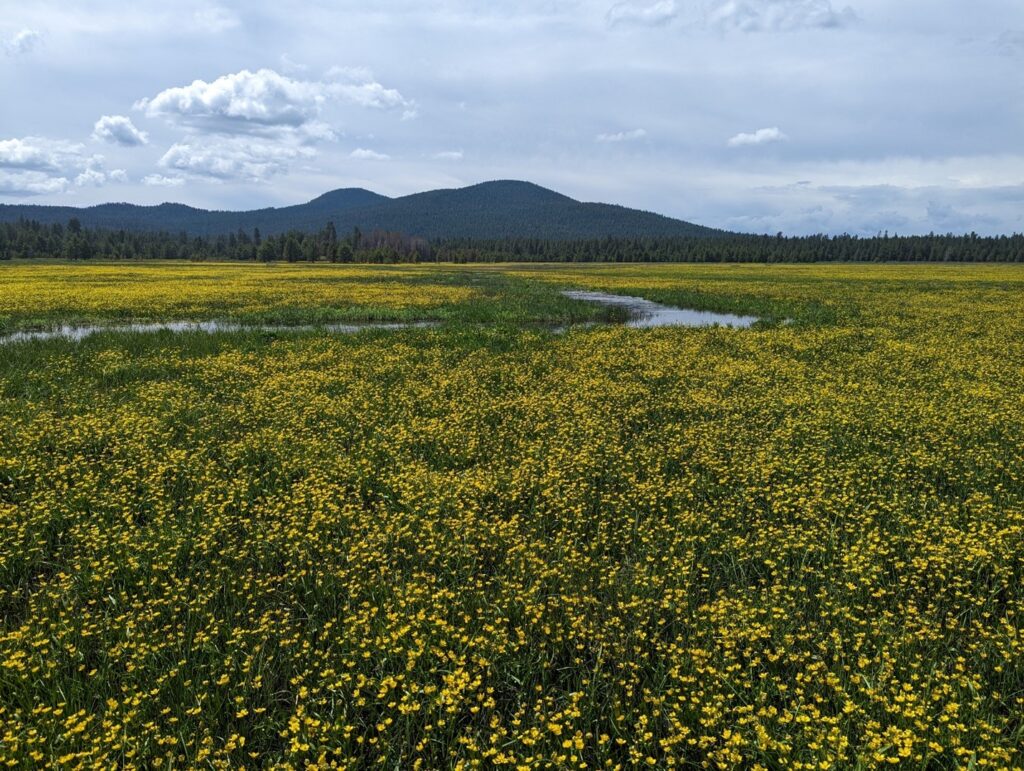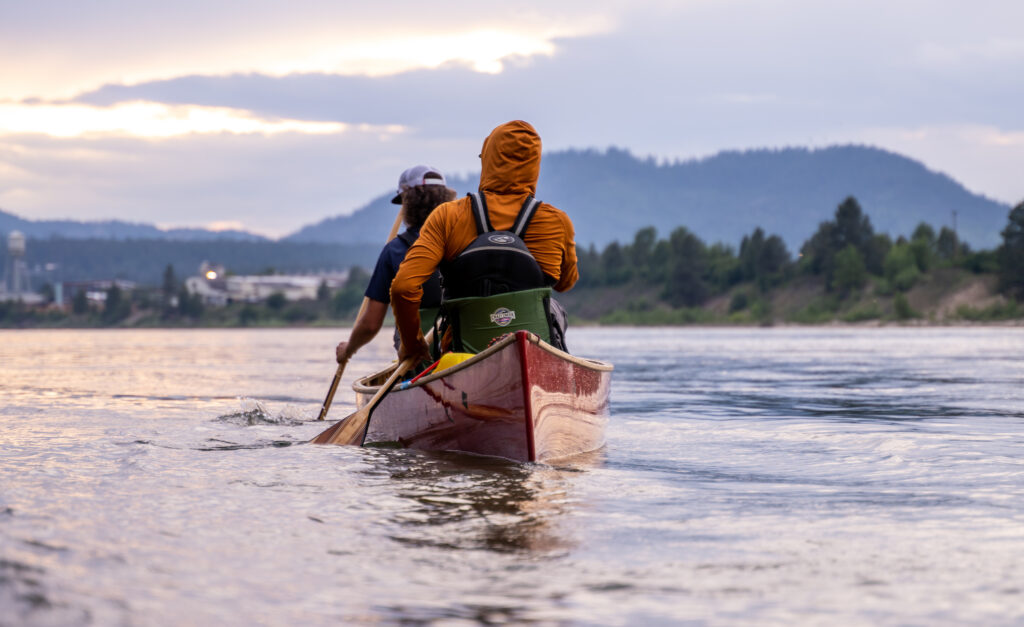Reviving Floodplains to Restore Habitat and Reduce Flood Damage
Washington State’s Floodplains by Design partnership is a national example for supporting floodplain restoration projects that benefit rivers, fish and public flood safety.
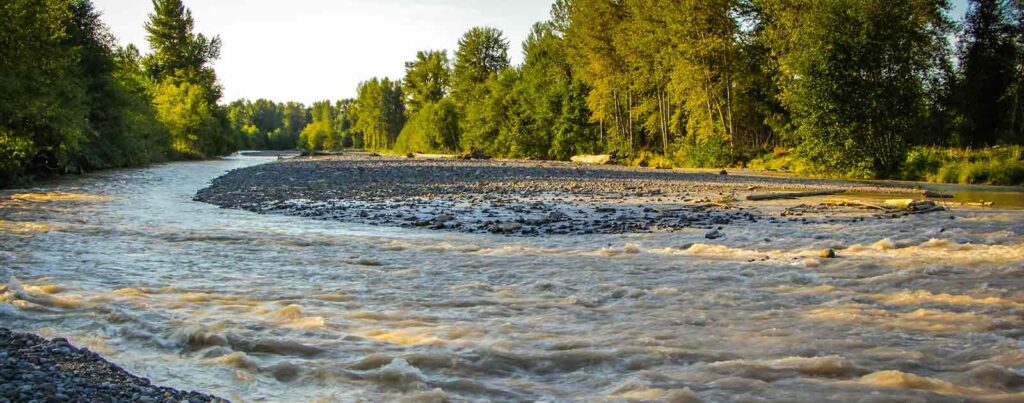
Standing on a brushy bank in soggy raincoats, we watched as the Puyallup River carried whole trees past us on swift silty-brown waters. Beside us a trickle of water began to meander through a breach in the riverbank and across a bed of dark glacial sediment. Days of rain across western Washington had engorged the region’s creeks and rivers, bringing many of them to flood stage. This is exactly what members of American Rivers’ River Restoration team and staff from Pierce County had come to see; a river using its floodplains.
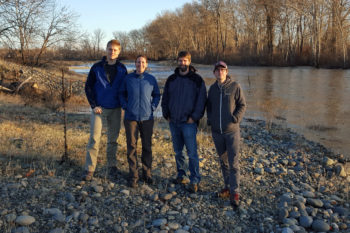
Michael Garrity, Brian Graber, Eileen Shader, and Jonathon Loos visit restored floodplains on the Yakima River in eastern Washington
This breach was not a natural feature of the riverbank, in fact, the riverbank we were walking on was not a ‘riverbank’ at all. It was a manmade levee historically built to protect adjacent lands from flood.
This particular reach of the Puyallup River is the site of a recently completed floodplain reconnection project by the Flood Control District of Pierce County, Washington. The levee breach we stood beside was the result of that project; a restored connection between the main channel of the Puyallup and the braided floodplain we had just walked across. We cheered on the trickle of water as it steadily crept onto the floodplain, charting a patient but clear course towards the historic side-channels of the Puyallup River.
A half-century ago the Puyallup was the focus of significant straightening and levee building, efforts intended to corral the river into a single channel and more quickly move flood waters and sediment downstream. Levees provided communities with an artificial sense of control over where the river could move and how often it could overtop its banks. Being perceived as reasonably safe from flood, the levees opened the river’s floodplains for people to cultivate and build on.
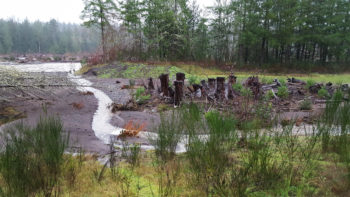
High waters can access historic side-channels of the Puyallup River as a result of levee setback projects by Pierce County in western Washington
Fast-forward to 2015 on the Puyallup River, where levees are being intentionally breached or setback to reconnect the river with its floodplains. Across the nation, people are beginning to recognize that floodplains benefit people, fish and wildlife, and the economy.
Communities of the Pacific Northwest are leading the way in acting on this through floodplain reconnection and restoration. Regional efforts resulted in the Floodplains by Design program, a partnership with Washington State’s Department of Ecology, the Puget Sound Partnership, and The Nature Conservancy. Floodplains by Design uses a competitive process to fund multi-benefit floodplain restoration projects that “improve flood protection for towns and farms, restore salmon habitats, improve water quality, and enhance outdoor recreation”.
It might seem counterintuitive to remove a levee to improve flood safety. After all, a levee is constructed to provide flood protection in the first place. The consequences of engineered flood control protection, such as levees and dams, are multifaceted, and not always obvious. A leveed river doesn’t stop flooding, it simply moves flood waters downstream more quickly. Oftentimes this results in more damaging floods downriver. Where a river isn’t constrained by levees, floodwaters can overtop riverbanks and spread across floodplain lands. In doing so, floodplains provide storage volume for floodwaters. Floodplain habitats slow moving water and allow debris and sediment to settle. By just allowing a river to access its floodplains flood levels can be lower, slower to occur, and overall less damaging in downstream reaches.
Most people likely think of floodplains as risk zones that require hazard mapping, extra building requirements or flood insurance. It turns out that a floodplain is more than just a land development term.
Floodplains support some of the most productive and diverse ecosystems on the planet, and support rivers and the surrounding environment. A river’s floodplains provide habitat for fish and wildlife, supply nutrients and shelter that enhance fish reproductive success and growth rates and help regulate in-stream temperature conditions and water quality.
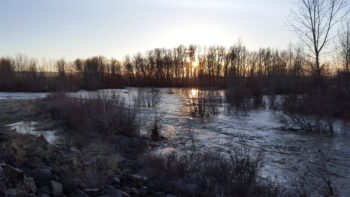
Floodplain restoration efforts by Yakima County on the Yakima River reconnect salmon with vital spawning habitat in the floodplain
When a river is leveed it becomes disconnected from its floodplain. Floodplain lands are often developed in response, eliminating the natural and beneficial functions they provide to ecosystems and people.
The impacts of floodplain loss are many, but one of the most apparent is the decline of floodplain dependent fish species.
This is the case in the Puget Sound watershed, where a combination of riverbank armoring and levees, alongside residential, commercial, industrial and agricultural development has resulted in a large scale loss of functioning floodplains. Endangered Chinook salmon, Steelhead and Bull trout depend on access to floodplain habitat features like log jams to spawn and grow. Puget Sound Chinook salmon populations are at 10% of their historic numbers today as reported by The Puget Sound Partnership, and are heavily supplemented by hatchery released fish.
As the current Lapham Fellow for American Rivers I’m working with our River Restoration Team to enhance our floodplain restoration program. American Rivers is a national leader at restoring rivers from headwaters to the sea through dam removal; we want to spur similar success in restoring connection between rivers and their floodplains. By learning from the successes of Washington’s Floodplains by Design program, and engaging with local leaders that have enabled those successes, we can position ourselves to enable floodplain restoration in river basins across the country.
As we stood in the rain along the Puyallup River in December, big grins on our faces, we were watching a river retake its floodplain for the first time in decades. The next day we had the opportunity to visit other successful floodplain reconnection projects on the Yakima River in eastern Washington. Excitement about these projects and the benefits they’re bringing to communities and rivers is palpable among local, county and state professionals. Witnessing these projects in action (especially during a week of downpours and flooding) helps us define what successful floodplain restoration looks like, and reaffirms the serious need for such work to continue. We’re eager to get started.
